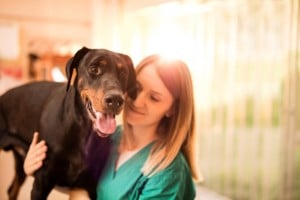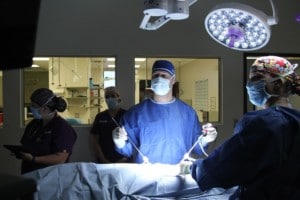 Your pet’s health and comfort are always our focus, and we pride ourselves on using cutting-edge techniques to provide the best medical care available. Our board-certified veterinary surgeons will partner with your family veterinarian to perform challenging surgeries that require specialized equipment, techniques, or expertise. In some cases, we can perform minimally invasive surgery to reduce your pet’s pain and healing time.
Your pet’s health and comfort are always our focus, and we pride ourselves on using cutting-edge techniques to provide the best medical care available. Our board-certified veterinary surgeons will partner with your family veterinarian to perform challenging surgeries that require specialized equipment, techniques, or expertise. In some cases, we can perform minimally invasive surgery to reduce your pet’s pain and healing time.
Minimally Invasive Surgery Techniques for Pets
Minimally invasive surgery uses techniques that cause less trauma and allow faster healing than traditional surgical methods. Veterinary surgeons make several small incisions instead of a single large incision to access a body cavity or joint, and an endoscope or arthroscope is used to visualize the surgical field. Endoscopes and arthroscopes are composed of a high-definition camera on the end of a rigid or flexible tube which is inserted through a small incision. The image is digitally transmitted to a screen, and can be magnified, which allows the surgeon to examine internal body structures. Instruments inserted through additional incisions can be used to inflate the body cavity with fluid or air, collect tissue samples, and cut and ligate tissue. Endoscopy and arthroscopy allow our surgeons to perform a number of minimally invasive procedures.
Arthroscopy in Pets
Arthroscopy, specifically, is minimally invasive joint surgery. The high-definition camera allows us to examine an entire diseased or injured joint surface, and provides more detail than the naked eye, so we do not miss any abnormalities. Traditional methods require surgeons to completely open a joint, which causes significantly more trauma, larger incisions, and longer healing times. The small incisions used during arthroscopic surgery are typically one-third to one-quarter of an inch long, and heal quickly, so your pet can get back on her feet again in no time.
Cranial cruciate ligament (CCL) injuries, which are commonly diagnosed in dogs, can cause debilitating pain and lameness, as well as accompanying meniscus injuries. These injuries can be diagnosed and treated using arthroscopy. Minimally invasive surgery is also often used to treat elbow dysplasia in dogs.
Laparoscopy in Pets
Since many organs are located in the abdominal cavity, abdominal surgery is one of the most commonly performed procedures in pets. Laparoscopy allows us to access abdominal structures through small incisions instead of completely opening the abdominal cavity, which makes a significant difference to your pet’s recovery time. In other cases, slightly larger incisions—between two and three inches—are used to perform laparoscopy-assisted surgery instead of a fully open approach.
Laparoscopy can be used for a variety of abdominal surgeries, including:
- Biopsy of organs, such as the liver, intestine, or spleen
- Gastric dilatation and volvulus (GDV) correction, which involves moving the stomach to its normal position
- Gastropexy, which is performed to prevent GDV in high-risk breeds, or after GDV correction to prevent recurrence
- Ovariohysterectomy (OVH), which is removal of the ovaries and uterus to prevent reproduction
- Ovariectomy, which involves removing only the ovaries, and is less invasive than an OVH
Thoracoscopy in Pets
Opening a pet’s chest cavity is particularly invasive, as it involves cutting through the sternum to access the heart or lungs. When our surgeons perform thoracoscopy, your pet suffers significantly less trauma and pain because only a few small incisions are made through her skin and musculature. Thoracoscopy can be used to obtain lung biopsies, and to relieve pericardial effusion (fluid accumulation in the membrane surrounding the heart). Traditional methods used to relieve pericardial effusion involve complete pericardium removal using an open-chest approach; however, thoracoscopy allows surgeons to make a small window in the pericardium to allow fluid drainage.
Minimally Invasive Surgery Candidates
Although minimally invasive surgery offers pets several benefits, some procedures must be performed with a more open approach for full surgical-field exposure and best results. Our veterinary surgeons will review your pet’s case and recommend the best procedure for her condition. We strive to keep your pet as comfortable as possible, and we take advantage of minimally invasive techniques when they will result in the best outcomes.
Contact us, or speak with your family veterinarian, if you would like to discuss the possibility of minimally invasive surgery for your pet.
- Management of Prolonged Starvation in a Cat –by Amaris Franco, DVM, DACVECC - June 13, 2024
- Canine Heat Stroke – by Jami Becker, DVM, DACVECC - May 20, 2024
- Bacterial Meningitis – by Tracy Sutton, DVM, DACVIM - January 29, 2024

